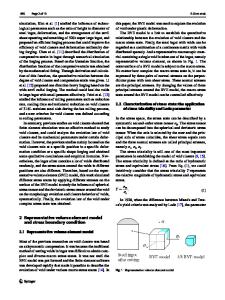Activation volume analysis of plastic deformation in fcc materials using nanoindentation
- PDF / 393,475 Bytes
- 6 Pages / 612 x 792 pts (letter) Page_size
- 76 Downloads / 312 Views
Y8.14.1
Activation volume analysis of plastic deformation in fcc materials using nanoindentation A. A. Elmustafa,§∗ M.F. T ambwe,₪ and D.S. Stone€ §
NASA Langley Research Center- ConITS, Hampton, VA, USA
₪Intel Corporation, Portland, OR, USA €
Department of Materials Science & Engineering, University of Wisconsin-Madison, Madison, WI, USA Abstract Activation volumes for plastic deformation of fcc metals are measured using nanoindentation. Materials include bulk, polycrystalline aluminum and α-brass, and sputtered copper and nickel thin films on silicon substrates. From a hardness measurement, V * is defined as 9k B T / ∂H / ∂ ln ε&eff , where H is the hardness and ε&eff is a representative strain rate beneath the indenter. Data obtained using nanoindentation are consistent with those obtained using more conventional experiments based on uniaxial loading. Introduction In plastic deformation, dislocation glide is thermally activated, and the flow stress is both rate- and temperature-dependent [1-5]. From the derivative of flow stress with respect to strain rate one can calculate the so-called “activation volume,” a measure of the area swept out during thermal activation (the “activation area”) multiplied by the Burgers vector. The trends in V* as functions of work hardening, solid solution strengthening, temperature, etc. are well established for many bulk materials. For instance, in bcc refractory metals the activation volume remains nearly constant as a function of flow stress as the latter changes resulting from work hardening or reduction in grain size. In these materials the Peierls stress is additive to the effects of work hardening and is otherwise independent of work hardening. In contrast, for fcc metals where the Peierls stress is low, the activation areas depend on level of work hardening because dislocationdislocation interactions dominate the kinetics of plasticity. In fcc solid solutions (such as αbrass) the activation volume varies slowly with stress at low levels of work hardening where dislocation-solute interactions dominate. But even when solid solution strengthening is present, if the material is work hardened to a sufficient level, dislocation-dislocation interactions again begin to dominate and the activation area becomes sensitive to the level of work hardening. Experimental techniques and analysis of activation volumes are well established for the study of bulk materials [1-5] using conventional testing methods (such as uniaxial loading in a tensile testing machine). Likewise, trends in activation volume for different materials are well established and reasonably well understood. Ideally we would like to extend the experimental methods for studying bulk materials to help us understand hardening mechanisms in thin films and surface layers. To do this, however, we need to apply a different kind of testing method because thin films and surface layers are difficult to characterize using more conventional methods involving a simple state of stress. One such method is nanoindentation. This method
Data Loading...











